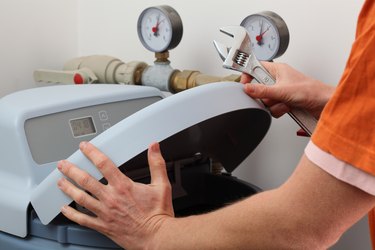
Resin is a critical part of a water softener system, and without it, your water softener won't operate properly. Unfortunately, resin doesn't last forever and needs to be changed about once every 10 years. Depending on your water quality, however, you may find you need to change your resin every five years instead. High levels of chlorine and iron in the water tend to deteriorate resin more quickly.
Here's what to know about resin and when to replace it in a water softener.
Video of the Day
Video of the Day
What the Resin Does
As hard water flows through your water softener, it comes into contact with the resin beads in the tank. When it does, the magnesium and calcium ions in the water cling to the resin, which removes them from the water. The resin essentially acts in the same manner as a water filter, trapping the chemicals you don't want in your water.
For some people, this simple explanation is enough. If you're into the science, though, you can think of the parts of a water softener as magnets. The calcium and magnesium in hard water are positively charged ions. The resin beads inside your softener are negatively charged. As the water passes through the resin, these opposites attract, and the resin grabs hold of the calcium and magnesium particles, removing them from the water.
But resin beads can only hold so much magnesium and calcium and as such need cleaning periodically. This happens during your softener's regeneration cycle. During a cleaning, positively charged salt and water are flushed through the resin beads, pulling the magnesium and calcium back out of the negatively charged resin. They then drain out of the tank with the salt water
Resin Change Timing
Although this water softening process works quite well, chlorine breaks down the glue that holds resin beads together, eventually turning them into worthless mush. Municipal water sources often contain chlorine, and the amount affects how long your resin beads will last. The higher the chlorine level, the shorter the life span of your resin.
Those using well water generally don't have to worry about chlorine but instead must focus on iron. Iron is very common in groundwater and fouls resin beads by coating them so magnesium and calcium can't reach them to stick to them. If there is iron in your water, you'll need to routinely clean your resin with an iron-removing product to keep your water softener working. Even with regular cleaning, your resin beads probably won't make it to the 10-year mark.
Where chlorine is a worry, the simplest indication that it's time to change your resin is to monitor salt use. If your water softener is using salt at its normal rate but the water coming out of it is harder, it's probably time for new resin. Harder water with a brown tint may indicate that iron has made it necessary to change your resin, although you can try cleaning it first.
Changing the Resin
To change the resin in your water softener, you must drain and disconnect the unit from the home's water pipes. You'll then take the top off the tank, remove the riser tube, and invert the tank over a sturdy trash receptacle to dump out the old resin. If you can't remove all of the resin using this method, you can carry the tank outside and flush it out with a garden hose. If you do, lay down towels or a tarp to catch the resin coming out of the tank.
Next, you'll install a new riser tube, refill the tank with new resin, and put the water softener back in service. The process is relatively simple if you have a good understanding of how to operate and unhook your water softener. It's a heavy, messy job, however, so there's no shame in leaving it to a pro if you prefer.